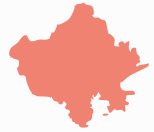Bundi | |
|---|---|
City | |
 Panoramic view of the old town and palace of Bundi. | |
| Coordinates: 25°26′N75°38′E / 25.44°N 75.64°E | |
| Country | |
| State | Rajasthan |
| District | Bundi |
| Named after | Bunda Meena |
| Government | |
| • Type | Municipal Council |
| • Body | Bundi Municipal Council [1] |
| Elevation | 268 m (879 ft) |
| Languages | |
| • Official | Hindi |
| Time zone | UTC+5:30 (IST) |
| PIN | 323001 |
| ISO 3166 code | RJ-IN |
| Vehicle registration | RJ-08 |
| Sex ratio | 922 ♂/♀ |
| Website | Bundi Municipal Council Bundi District |
Bundi is a city in the Hadoti region of Rajasthan state in northwest India.



